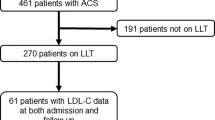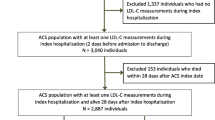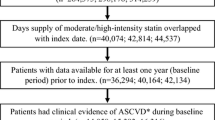Abstract
Objectives
According to various national and international guidelines, the target LDL-C level is <100 mg/dl for patients with established coronary heart disease (CHD) or CHD risk equivalent (CE). We aimed to investigate aspects of the lipid-lowering management of patients at high cardiovascular risk in-hospital care and the achievement of target values.
Methods
In the internet-based 2L registry in Germany (2005–2006), cardiologists in 42 hospitals documented at a single visit 3,131 consecutive patients with known CHD, and/or diabetes mellitus, peripheral arterial disease, or a 10-year CHD risk >20% (summarized as CE), who were on chronic statin treatment. They received instructions on the guidelines and instant feedback on the effect of their treatment decisions (educational study component).
Results
The three groups comprised 1,458 patients with CHD + CE (46.6%; median LDL-C 107 mg/dl), 1,104 patients with CHD only (35.3%; median LDL-C 104 mg/dl), and 569 with CE only (18.2%; median LDL-C 111 mg/dl). At admission, LDL-C levels <100 mg/dl were observed in 43.1, 44.8 and 37.9% of patients in the three groups, respectively. Statin doses at admission were usually in the low to intermediate range (e.g., simvastatin 10–20 mg/day). Cardiologists switched to another statin in 14.6%, increased the dose of statins (if same drug) in 22.9% (mean increase from 26.8 mg/day at baseline to 31.6 mg/day) and/or added a cholesterol absorption inhibitor (CAI) in 11.6%. The cardiologists’ intervention improved estimated LDL-C levels (using a lipid calculator); however, the 100 mg/dl LDL-C target was only reached in 49.0, 48.5, and 42.9%.
Conclusions
When compared with earlier studies in the outpatient setting, the treatment to target for LDL-C of high-risk CHD patients has improved, but is not satisfactory.


Similar content being viewed by others
References
Assmann G, Schulte H, Cullen P, Neiss A, Bestehorn K (2007) Treatment of hyperlipidemia in primary practise in Germany: sub-group analyses from the 4E-registry with particular emphasis on men and women with diabetes mellitus. Exp Clin Endocrinol Diabetes 115:85–91
Assmann G, Schulte H, Cullen P, Seedorf U (2007) Assessing risk of myocardial infarction and stroke: new data from the Prospective Cardiovascular Munster (PROCAM) study. Eur J Clin Invest 37:925–932
Bakris G, Bohm M, Dagenais G, Diener HC, Fujita T, Gorelick P, Kjeldsen SE, Laakso M, Mancia G, Pitt B, Sharma A, Sleight P, Teo K, Unger T, Weber M, Williams B, Zannad F (2008) Cardiovascular protection for all individuals at high risk: evidence-based best practice. Clin Res Cardiol 97:713–725
Bestehorn K, Jannowitz C, Karmann B, Pittrow D, Kirch W (2009) Characteristics, management and attainment of lipid target levels in patients enrolled in Disease Management Program versus those in routine care: LUTZ registry. BMC Public Health 9:280
Bestehorn K, Schäfer J, Gitt A, Jannowitz C, Karmann B, Sonntag FJ, Weizel A (2008) Leitliniengerechte Lipidtherapie und Zielwerterreichung bei Risikopatienten im klinischen Alltag. Rationale, Ziele und Design des LIMA-Registers. MMW Fortschr Med 150 Suppl:135–141
Bischoff B, Silber S, Richartz BM, Pieper L, Klotsche J, Wittchen HU (2006) Inadequate medical treatment of patients with coronary artery disease by primary care physicians in Germany. Clin Res Cardiol 95:405–412
Bohler S, Scharnagel H, Freisinger F, Stojakovic T, Glaesmer H, Klotsche J, Pieper L, Pittrow D, Kirch W, Schneider H, Stalla GK, Lehnert H, Zeiher AM, Silber S, Koch U, Ruf G, Marz W, Wittchen HU (2006) Unmet needs in the diagnosis and treatment of dyslipidemia in the primary care setting in Germany. Atherosclerosis. doi:10.1016/j.atherosclerosis.2006.02.025
Cannon CP, Braunwald E, McCabe CH, Rader DJ, Rouleau JL, Belder R, Joyal SV, Hill KA, Pfeffer MA, Skene AM, the Pravastatin or Atorvastatin Evaluation, Infection Therapy—Thrombolysis in Myocardial Infarction 22 Investigators (2004) Comparison of intensive and moderate lipid lowering with statins after acute coronary syndromes. N Engl J Med 350:1495–1504
Cohen JC, Boerwinkle E, Mosley TH Jr, Hobbs HH (2006) Sequence variations in PCSK9, low LDL, and protection against coronary heart disease. N Engl J Med 354:1264–1272
D’Agostino RB Sr, Grundy S, Sullivan LM, Wilson P (2001) Validation of the Framingham coronary heart disease prediction scores: results of a multiple ethnic groups investigation. JAMA 286:180–187
Davidson MH, Maki KC, Pearson TA, Pasternak RC, Deedwania PC, McKenney JM, Fonarow GC, Maron DJ, Ansell BJ, Clark LT, Ballantyne CM (2005) Results of the National Cholesterol Education (NCEP) Program Evaluation ProjecT Utilizing Novel E-Technology (NEPTUNE) II survey and implications for treatment under the recent NCEP Writing Group recommendations. Am J Cardiol 96:556–563
Diehm C, Schuster A, Allenberg H, Darius H, Haberl R, Lange S, Pittrow D, von Stritzky B, Tepohl G, Trampisch H (2004) High prevalence of peripheral arterial disease and comorbidity in 6,880 primary care patients: cross sectional study. Atherosclerosis 172:95–105
Fagan T (1994) Remembering the lessons of basic pharmacology. Arch Intern Med 154:1430–1431
Federal Statistical Office Leading causes for death in 2007. http://www-ec.destatis.de/csp/shop/sfg/bpm.html.cms.cBroker.cls?cmspath=struktur,vollanzeige.csp&ID=1022599. Accessed 12 Oct 2010
Friedmann PD, Brett AS, Mayo-Smith MF (1996) Differences in generalists’ and cardiologists’ perceptions of cardiovascular risk and the outcomes of preventive therapy in cardiovascular disease. Ann Intern Med 124:414–421
Gitt AK, Juenger C, Jannowitz C, Karmann B, Senges J, Bestehorn K (2009) Guideline-oriented ambulatory lipid-lowering therapy of patients at high risk for cardiovascular events by cardiologists in clinical practice: the 2L cardio registry. Eur J Cardiovasc Prev Rehabil 16:438–444
Gohlke H, Kubler W, Mathes P, Meinertz T, Schuler G, Gysan DB, Sauer G (2001) Recommendations for an extensive risk decrease for patients with coronary disease, vascular diseases and diabetes. Issued by the Executive Committee of the German Society of Cardiology, Heart and Circulation Research, reviewed on behalf of the Clinical Cardiology Commission by the Prevention Project Group. Z Kardiol 90:148–149
Grundy SM, Cleeman JI, Merz CN, Brewer HB Jr, Clark LT, Hunninghake DB, Pasternak RC, Smith SC Jr, Stone NJ (2004) Implications of recent clinical trials for the National Cholesterol Education Program Adult Treatment Panel III guidelines. Circulation 110:227–239
Hildemann SK, Barho C, Karmann B, Darius H, Bestehorn K (2007) Dual cholesterol inhibition with ezetimibe/simvastatin in pre-treated hypercholesterolaemic patients with coronary heart disease or diabetes mellitus: prospective observational cohort studies in clinical practice. Curr Med Res Opin 23:713–719
Hildemann SK, Barho C, Karmann B, Darius H, Bode C (2008) Sustained effects in hypercholesterolaemic patients on combined simvastatin/ezetimibe treatment: observational cohort study in clinical practice. Curr Med Res Opin 24:2777–2784
Kanstrup H, Lassen JF, Heickendorff L, Lauritzen T, Larsen ML (2004) Quality of lipid-lowering therapy in patients with ischaemic heart disease: a register-based study in 3477 patients. J Intern Med 255:367–372
Keevil JG, Cullen MW, Gangnon R, McBride PE, Stein JH (2007) Implications of cardiac risk and low-density lipoprotein cholesterol distributions in the United States for the diagnosis and treatment of dyslipidemia: data from National Health and Nutrition Examination Survey 1999 to 2002. Circulation 115:1363–1370
Knopp RH (1999) Drug treatment of lipid disorders. N Engl J Med 341:498–511
Lange S, Trampisch HJ, Haberl R, Darius H, Pittrow D, Schuster A, von Stritzky B, Tepohl G, Allenberg JR, Diehm C (2005) Excess 1-year cardiovascular risk in elderly primary care patients with a low ankle-brachial index (ABI) and high homocysteine level. Atherosclerosis 178:351–357
Law MR, Wald NJ, Rudnicka AR (2003) Quantifying effect of statins on low density lipoprotein cholesterol, ischaemic heart disease, and stroke: systematic review and meta-analysis. Br Med J 326:1423–1430
Marma AK, Lloyd-Jones DM (2009) Systematic examination of the updated Framingham heart study general cardiovascular risk profile. Circulation 120:384–390
McKenney JM (2004) Optimizing LDL-C lowering with statins. Am J Ther 11:54–59
Mosca L (2007) Guidelines for prevention of cardiovascular disease in women: a summary of recommendations. Prev Cardiol 10:19–25
Mosca L, Linfante AH, Benjamin EJ, Berra K, Hayes SN, Walsh BW, Fabunmi RP, Kwan J, Mills T, Simpson SL (2005) National study of physician awareness and adherence to cardiovascular disease prevention guidelines. Circulation 111:499–510
NCEP ATP III Guidelines at A Glance Quick Desk Reference. Available at http://www.nhlbi.nih.gov/guidelines/cholesterol/atglance.pdf. Accessed 12 Oct 2010
Ose L, Skjeldestad FE, Bakken IJ, Levorsen A, Alemao EA, Yin DD, Borgstrom F, Jonsson L (2006) Lipid management and cholesterol goal attainment in Norway. Am J Cardiovasc Drugs 6:121–128
Ovbiagele B, Liebeskind DS, Kim D, Ali LK, Pineda S, Saver JL (2010) Prognostic value of Framingham Cardiovascular Risk Score in hospitalized stroke patients. J Stroke Cerebrovasc Dis
Pearson TA, Denke MA, McBride PE, Battisti WP, Brady WE, Palmisano J (2005) A community-based, randomized trial of ezetimibe added to statin therapy to attain NCEP ATP III goals for LDL cholesterol in hypercholesterolemic patients: the ezetimibe add-on to statin for effectiveness (EASE) trial. Mayo Clin Proc 80:587–595
Persell SD, Lloyd-Jones DM, Baker DW (2006) Implications of changing national cholesterol education program goals for the treatment and control of hypercholesterolemia. J Gen Intern Med 21:171–176
Psaty BM, Koepsell TD, Lin D, Weiss NS, Siscovick DS, Rosendaal FR, Pahor M, Furberg CD (1999) Assessment and control for confounding by indication in observational studies. J Am Geriatr Soc 47:749–754
Ruof J, Klein G, Marz W, Wollschlager H, Neiss A, Wehling M (2002) Lipid-lowering medication for secondary prevention of coronary heart disease in a German outpatient population: the gap between treatment guidelines and real life treatment patterns. Prev Med 35:48–53
Ryden L, Standl E, Bartnik M, Van den Berghe G, Betteridge J, de Boer MJ, Cosentino F, Jonsson B, Laakso M, Malmberg K, Priori S, Ostergren J, Tuomilehto J, Thrainsdottir I, Vanhorebeek I, Stramba-Badiale M, Lindgren P, Qiao Q, Priori SG, Blanc JJ, Budaj A, Camm J, Dean V, Deckers J, Dickstein K, Lekakis J, McGregor K, Metra M, Morais J, Osterspey A, Tamargo J, Zamorano JL, Deckers JW, Bertrand M, Charbonnel B, Erdmann E, Ferrannini E, Flyvbjerg A, Gohlke H, Juanatey JR, Graham I, Monteiro PF, Parhofer K, Pyorala K, Raz I, Schernthaner G, Volpe M, Wood D (2007) Guidelines on diabetes, pre-diabetes, and cardiovascular diseases: executive summary: The Task Force on Diabetes and Cardiovascular Diseases of the European Society of Cardiology (ESC) and of the European Association for the Study of Diabetes (EASD). Eur Heart J 28:88–136
Sharma M, Ansari MT, Abou-Setta AM, Soares-Weiser K, Ooi TC, Sears M, Yazdi F, Tsertsvadze A, Moher D (2009) Systematic review: comparative effectiveness and harms of combinations of lipid-modifying agents and high-dose statin monotherapy. Ann Intern Med, p 151 [Epub ahead of print]
Silber S, Jarre F, Pittrow D, Klotsche J, Pieper L, Zeiher A, Wittchen H, for the DETECT Study Group Cardiovascular risk assessment in primary care (DETECT) (2008) What is the concordance between physician assessment and established risk scores? Med Klin 103(9):638–645 (article in German)
Smith SC Jr, Allen J, Blair SN, Bonow RO, Brass LM, Fonarow GC, Grundy SM, Hiratzka L, Jones D, Krumholz HM, Mosca L, Pasternak RC, Pearson T, Pfeffer MA, Taubert KA (2006) AHA/ACC guidelines for secondary prevention for patients with coronary and other atherosclerotic vascular disease: 2006 update: endorsed by the National Heart, Lung, and Blood Institute. Circulation 113:2363–2372
Steg PG, Bhatt DL, Wilson PW, D’Agostino R Sr, Ohman EM, Rother J, Liau CS, Hirsch AT, Mas JL, Ikeda Y, Pencina MJ, Goto S (2007) One-year cardiovascular event rates in outpatients with atherothrombosis. JAMA 297:1197–1206
Valuck RJ, Williams SA, MacArthur M, Saseen JJ, Nair KV, McCollum M, Ensor JE (2003) A retrospective cohort study of correlates of response to pharmacologic therapy for hyperlipidemia in members of a managed care organization. Clin Ther 25:2936–2957
Völler H, Reibis R, Pittrow D, Jannowitz C, Wegscheider K, Karmann B, Bestehorn K (2009) Secondary prevention of diabetic patients with coronary artery disease in cardiac rehabilitation: risk factors, treatment and target level attainment. Curr Med Res Opin 25:879–890
Acknowledgments
The registry was funded by MSD SHARP and DOHME GmbH, Haar and Essex Pharma GmbH, Munich, Germany.
Conflict of interest
C. Jannowitz and K. Bestehorn are employees of MSD Germany; B. Karmann is an employee of Essex Pharma, Germany. A. Gitt and J. Senges have received research grants from MSD and Essex Pharma Germany. The authors acknowledge the contribution of Prof. Dr. Pittrow, Institute for Clinical Pharmacology, to the interpretation of results.
Author information
Authors and Affiliations
Corresponding author
Rights and permissions
About this article
Cite this article
Gitt, A.K., Jünger, C., Jannowitz, C. et al. Adherence of hospital-based cardiologists to lipid guidelines in patients at high risk for cardiovascular events (2L registry). Clin Res Cardiol 100, 277–287 (2011). https://doi.org/10.1007/s00392-010-0240-9
Received:
Accepted:
Published:
Issue Date:
DOI: https://doi.org/10.1007/s00392-010-0240-9




